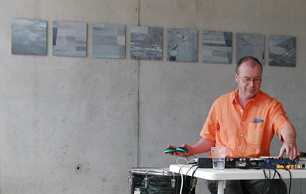Günter Müller

Günter Müller es un artista sonoro nacido en Alemania pero que vive en Suiza desde muy temprana edad. Se inició como percusionista y turntablista, además de utilizar micrófonos y un amplificador, con lo cual producía bases rítmicas. De esta forma descubre la electrónica como una forma de manipular sonidos. Luego reemplaza el micrófono por el minidisc y más tarde por el ipod. Esto último hoy en día está utilizando además del computador.
Müller básicamente en sus sets improvisa con esta amalgama de sonidos, transformándolos y produciendo nuevas tonalidades y texturas oscuras, sin que hayan drones planos, sino que una densa estática cuyos ruidos producen una percusión granular.
Desde mediados de los ’80 ha grabado más de 90 discos ya sea en solitario como en colaboraciones con otros artistas. Como dúo junto a Tetuzi Akiyama, Taku Sugimoto, Jason Kahn, Steinbrüchel, Norbert Möslang, Toshimaru Nakamura, Tomas Korber, Lê Quan Ninh, Keith Rowe, Erikm, Carlos Zingaro, Sachiko M, Michel Doneda, Fabrice Charles, entre otros.
También ha trabajado con un amplio espectro de músicos como Jim O’Rourke, Christian Marclay, Butch Morris y Otomo Yoshihide. Recientemente el 9 y 10 de febrero tocó en Buenos Aires haciendo dos tríos con artistas argentinos, el primero junto a Pablo Reche y Alan Courtis y el segundo con Gabriel Paiuk y Sergio Merce.
Pronto inicia una gira a Japón en la que tocará junto a renombrados artistas de la escena de improvisación japonesa.
Sus discos han sido editados en su propio sello For 4 Ears – que fundó en 1994 – y en Erstwhile, Cut (de Jason Khan), Grob, List, Audiosphere, Amoebic, Rossbin y Creative Sources.
Sitios de interés:
www.for4ears.com
www.home.datacomm.ch/g.mueller/mueller.htm
Günter Müller is a sound artist born in Germany but living in Switzerland since an early age. He started as a percussionist, using microphones and an amplifier, with which he produced rhythmical sections. As a form to manipulate and create new sounds he got into electronics. Soon he replaced the microphone by minidisc and later by an iPod. Nowadays he’s using in addition to the latter a software design.
Müller basically in his sets improvises with this amalgam of sounds, transforming them and producing new tonalities and dark textures, along with drones, dense static whose noises produce a granular percussion.
From mid 80s he has released more than 90 records solo, and in collaborations with other artists. As a duo alongside guitarists Tetuzi Akiyama and Taku Sugimoto, Jason Kahn, Steinbrüchel, Norbert Möslang, Toshimaru Nakamura, Korber Takings, Lê Quan Ninh, Keith Rowe, Erikm, Carlos Zingaro, Sachiko M, Michel Doneda, Fabrice Charles, etc.
He also has worked with various musicians like Jim O’Rourke, Christian Marclay, Butch Morris and Otomo Yoshihide.
Recently on February 9th and 10th he played two trios together with Argentinean artists, the first one alongside Pablo Reche and Alan Courtis, and the other one, along with Gabriel Paiuk and Sergio Merce in Buenos Aires. Soon he’s touring to Japan where he’s going to play with renowned Japanese artists.
His records have been published on his own label For 4 Ears – which he founded in 1994 – and on Erstwhile, Cut (of Jason Khan), Grob, List, Audiosphere, Amoebic, Rossbin, Creative Sources.
Links of interest:
www.for4ears.com
www.home.datacomm.ch/g.mueller/mueller.htm
Me pregunto porqué las voces de los registros de campo como los de ‘Wireless_Within’, por ejemplo, se acoplan tan bien en una música tan abstracta. ¿Cuál es tu opinión al respecto?
“En efecto cada sonido es, sin importar si es un sonido natural o un sonido producido por la máquina que sea o por instrumentos musicales; una información acústica con la que puedes trabajar. Por supuesto ha habido algunas conexiones con la vida real cuando se escuchan voces de grabaciones de campo en el estudio junto a Phil [Samartzis], pero esas informaciones son menos importantes que lo puramente musical y calidad de sonido. Quizá sonidos ‘abstractos’ realizados por la electrónica o cualquier otro instrumento pueden ser vistos más concretamente que aquellos de los registros de campo. O una pregunta interesante podría ser cómo tocar un tambor que se convierte con la calidad de un sonido grabado como registro de campo”.
Como debes tener una buena colección de sonidos, ¿debes conocerlos muy bien de tal manera de escoger aquellos que quieres usar en tu tocata en live-electronics?
“A un cierto nivel debo conocer muy bien mi colección. Pero a veces cuando busco un sonido, lo escojo revisando mis archivos al azar y cuando lo escucho antes de mostrarlo, me doy cuenta que encaja perfectamente, en la medida que el sonido sea importante en sí mismo, depende de cómo lo manejes y cómo se trabaje en el contexto musical de un concierto”.
¿Es diferente el enfoque musical para un acto de danza o una instalación sonora?
“En la danza hay un bailarín y un compañero con quien bailar. El bailarín tiene una participación activa, reacciones, da señales. En una instalación sonora es una pieza que habla al comienzo, pero es menos en vivo que un ser humano”.
¿Tendremos alguna oportunidad de verte tocando en Sudamérica?
A principios del próximo año voy a ir a tocar a Buenos Aires junto a Gabriel Paiuk, Alan Courtis, Sergio Merce y Pablo Reche. Esta es la primera vez que voy a Sudamérica.
Texto: Guillermo Escudero
Noviembre 2005
I wonder why the voices from field recordings like the ones on “Wireless_Within”, for example, fit so well into such an abstract music. What’s your opinion about?
“In fact every sound is, no matter if it’s a natural sound or a sound produced by any machines or music instruments, an acoustic information you musically can work with. Of course there have been some connections to real life when hearing voices from field recordings at the recording studio with Phil [Samartzis], but those informations are less important than their pure musical and sound quality. Perhaps ‘abstract’ sounds done by an electronic or any other instrument can be seen as much concretely as those from field recordings. Or an interesting question would be how to play a snare drum that it becomes the quality of a field recorded sound.”
As you may have a good collection of sounds, you must know them very well in order to choose the ones you want to use in your live electronics?
“To a certain level I have to know my collection very well. But sometimes when looking for a sound, I’m choosing one scrolling through my files more or less by chance and when prelistening to it I realize it fits totally well. At least as important as the sound itself is how to handle the sound, how to work with it in the musical context of a concert.”
Is it different your music approach for a dance act or a sound installation?
“In a dance act there is the dancer as a partner to play with. The dancer has an active part, reacts, gives inputs. In a sound installation it is the room that speaks at the beginning, brings me to some ideas, but it is of course less live than a human being.”
Is there any chance to see you playing in South America?
I’m going to play in Buenos Aires early next year with Gabriel Paiuk, Alan Courtis, Sergio Merce and Pablo Reche. It’s the first time for me to come to South America.”
Text: Guillermo Escudero
November 2005

